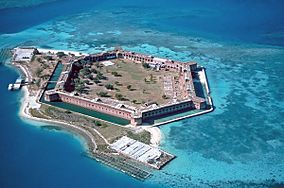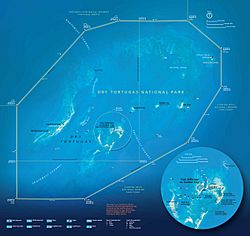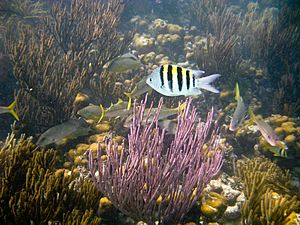Dry Tortugas National Park facts for kids
Quick facts for kids Dry Tortugas National Park |
|
|---|---|
|
IUCN Category II (National Park)
|
|

Fort Jefferson and Garden Key
|
|
| Location | Monroe County, Florida, United States |
| Nearest city | Key West |
| Area | 64,701 acres (261.84 km2) |
| Established | January 4, 1935 |
| Visitors | 56,810 (in 2018) |
| Governing body | National Park Service |
| Website | Dry Tortugas National Park |

National Park Service map of the Dry Tortugas
|
|
| Geography | |
|---|---|
| Location | end of the Florida Keys, United States |
| Coordinates | 24°38′00″N 82°55′12″W / 24.63333°N 82.92000°W |
| Archipelago | Florida Keys |
| Adjacent bodies of water | Gulf of Mexico |
| Total islands | 7 |
| Major islands | Garden Key |
| Area | 10,000,000 acres (4,000,000 ha) |
| Highest elevation | 10 ft (3 m) |
Dry Tortugas National Park is a special place in the United States. It is a national park located about 68 miles (109 km) west of Key West, Florida, in the Gulf of Mexico. This park protects Fort Jefferson and the small group of islands called the Dry Tortugas. These islands are the most western and isolated part of the Florida Keys.
The park is famous for its amazing sea life, tropical birds, colorful coral reefs, and old shipwrecks. The main attraction is Fort Jefferson, a huge but unfinished fortress made of bricks. It is the largest brick building in the Western Hemisphere, built with over 16 million bricks! Dry Tortugas is unique because it has both a beautiful, untouched tropical ecosystem and important historical sites.
You can only reach the park by seaplane or boat. Many people visit each year to enjoy activities like snorkeling, picnicking, birdwatching, camping, scuba diving, fishing, and kayaking. If you want to stay overnight, there are a few campsites on Garden Key, right next to Fort Jefferson. The park is also part of the Everglades & Dry Tortugas Biosphere Reserve, recognized by UNESCO for its natural importance.
Contents
Geography of the Dry Tortugas
The Dry Tortugas are a small group of coral islands located about 70 miles (113 km) west of Key West, Florida. They are the very end of the Florida Keys. Most of the park area, over 99 percent, is water. A large part of the northern and western sections of the park is a special research area. In this area, you cannot take any sea life, and boats must use special mooring buoys instead of dropping anchor. About half of the park is still open for fishing.
The islands are low and have uneven shapes. Some have thin growths of mangrove trees and other plants, while smaller islands might only have patches of grass or no plants at all. There are usually seven islands, but the number can change. The islands are always changing size and shape because of water levels and sand movement. Sometimes, smaller islands disappear and then reappear after hurricanes.
The main islands in the park, from west to east, are:
- Loggerhead Key: This is the largest island, about 0.1 square miles (0.26 square km) in size. It is also the highest point in the Dry Tortugas, about 10 feet (3 meters) above sea level. The tall Dry Tortugas lighthouse, 150 feet (46 meters) high, is on this island.
- Garden Key: This island is home to Fort Jefferson and an old lighthouse. It is the second largest island, about 0.06 square miles (0.17 square km) in size.
- Bush Key: This island is very close to Garden Key. It was once called Hog Island because pigs were raised there for the prisoners at Fort Jefferson. Sometimes, a sand bar connects Bush Key to Garden Key. Bush Key is the third largest island, about 0.05 square miles (0.12 square km). It is a very important place for terns to nest. Because of this, visitors cannot go to Bush Key from February to September to protect the nesting sooty terns and brown noddys.
- Long Key: This small island is south of Bush Key. Sometimes, it is connected to Bush Key by a sandbar.
- Hospital Key: This island got its name because a hospital for people at Fort Jefferson was built there in the 1870s.
- Middle Key: This island is not always above sea level. It can disappear for weeks or months due to changes in seasons, storms, and tides, and then reappear.
- East Key: This island is about 0.006 square miles (0.016 square km) and is over 6 feet (2 meters) high.
The three largest islands (Loggerhead Key, Garden Key, and Bush Key) make up about 93 percent of all the land in the Dry Tortugas.
Geology of the Islands
The Dry Tortugas islands are the western part of a chain of islands made of limestone. These islands, including the Florida Keys, sit on a very thick platform of carbonate rock. This platform has been forming for millions of years. The islands are made of two main types of rock: Key Largo Limestone and Miami Limestone. Key Largo Limestone comes from old coral reefs, while Miami Limestone formed from sand and shell fragments. You can also find modern sand deposits here, made mostly of tiny pieces of a type of green algae called Halimeda.
Climate and Weather
Dry Tortugas has a tropical savanna climate. This means it has a rainy season from May to October, which is also when hurricanes are most likely. The dry season is from November to April. Even though it's in a tropical area, Dry Tortugas is the driest place in Florida, getting about 38 inches (965 mm) of rain each year. There are no large forests on the islands, and the sandy soil drains water quickly, making it feel very dry.
Temperatures don't change much throughout the year. In summer, high temperatures are around 91°F (33°C), and in winter, low temperatures are around 65°F (18°C). It has never been cold enough for frost or a freeze here.
History of Dry Tortugas
The first European to see the Dry Tortugas was Juan Ponce de León on June 21, 1513. He caught 160 sea turtles there, so he named the islands "Tortugas," which means turtles in Spanish. They are called Dry because there is no fresh water on the islands. This name is one of the oldest European place-names still used in the U.S.
The area has many old shipwrecks, some dating back to the 1600s. In 1742, a British ship called HMS Tyger wrecked here. The crew lived on Garden Key for 56 days before sailing to Jamaica.
When the United States got Florida from Spain in 1819, the Dry Tortugas were seen as a very important spot to control the Straits of Florida and the Gulf of Mexico. Work on a lighthouse on Garden Key began in 1825. Later, in 1856, a new, stronger lighthouse was built on Loggerhead Key to replace the older one.
The Dry Tortugas are also rich in maritime history. In 1989, explorers found a shipwreck believed to be part of the 1622 Spanish treasure fleet. This wreck, found deep underwater, had olive jars, copper, gold, silver, glass, and other old items. On September 6, 1622, a severe hurricane hit the Spanish ship Nuestra Señora de Atocha, causing it to sink near the Dry Tortugas. Mel Fisher and his team found this famous wreck on July 20, 1985. They recovered an estimated $450 million worth of treasure, including 40 tons of gold and silver, over 100,000 Spanish silver coins, gold coins, Colombian emeralds, and many gold and silver items. Fisher's company also found other shipwrecks nearby, including the Atocha's sister ship, the Santa Margarita, and a slave ship called the Henrietta Marie.
Fort Jefferson: A Giant Fortress
Fort Jefferson is a huge but unfinished coastal fortress. It is the largest structure made of masonry (like bricks and stone) in the Western Hemisphere. It was built with more than 16 million bricks!
Building the fort started in 1847. By 1860, it was about half finished. Many of the workers were enslaved people hired from their owners in Key West and other parts of Florida. Some white workers, often Irish immigrants, also helped. The use of enslaved labor stopped in 1863.
During the American Civil War, the fort stayed under the control of the Union army. After the war, it was used as a prison until 1874. One famous prisoner was Dr. Samuel Mudd, who was imprisoned for his connection to the Lincoln assassination. He was later pardoned after helping to stop a disease outbreak at the fort.
In the 1880s, the Navy set up a base at Dry Tortugas. They also built a place for ships to refuel with coal and a wireless (radio) station. During World War I, a seaplane base was built on the islands, but it was closed soon after.
From 1903 to 1939, the Carnegie Institution of Washington ran a Marine Biology Laboratory on Loggerhead Key. This lab became one of the best places in the tropical world for studying marine life. Many researchers used its facilities for their studies.
African Americans at Fort Jefferson
African Americans lived at Fort Jefferson not only as enslaved people but also as Union Soldiers, freed people, and prisoners. From 1847, the United States Army Corps of Engineers hired enslaved workers. Between 1847 and 1860, about 17% of the enslaved people in Key West were leased to the Army Corps to work as laborers. Most of these enslaved workers were men who did the hard, unskilled jobs. Some also worked as cooks or boatmen. Enslaved women were also present, doing laundry and some cooking.
After the Emancipation Proclamation (which declared enslaved people free), some African American men joined the Union Army. The 82nd Colored Infantry was stationed at Fort Jefferson near the end of the American Civil War. Between 1861 and 1871, African Americans were also held as military prisoners at the fort.
Park History and Protection
Dry Tortugas National Park was first created as Fort Jefferson National Monument on January 4, 1935, by President Franklin D. Roosevelt. It was expanded in 1983 and then became Dry Tortugas National Park on October 26, 1992. The park is managed by the same team that manages Everglades National Park. The main goals of the park are to protect the islands and marine life, preserve Fort Jefferson and underwater historical sites like shipwrecks, and allow people to visit in a safe and controlled way.
During a time when the U.S. government shut down in 1995–1996, Dry Tortugas National Park, like all other national parks, was closed. The people of Key West, Florida, who rely on tourism, tried to raise money to keep the park open. When they couldn't find anyone to accept the money, they sent a group of civilian boats and fire department boats to Fort Jefferson to reopen the park themselves. This event was part of the story of the satirical micronation called the Conch Republic.
The park is also a place where immigrants from Cuba sometimes arrive in homemade boats. Dealing with these arrivals is challenging for the park because it has limited resources and is far from help like the Coast Guard.
The number of visitors to the park grew for many years, reaching a high of over 83,000 in 2000. Since then, the number has slowly gone down, averaging about 63,000 visitors per year.
In August 2004, Hurricane Charley hit the Dry Tortugas directly. In September 2022, Hurricane Ian also struck the islands.
Ecology and Wildlife

The Dry Tortugas islands have a unique ecosystem that is a mix of subtropical and tropical life. This means you can find species here that usually don't live or breed anywhere else in the continental United States.
In 1977, a very cold weather event killed 96 percent of the branching coral in the area. What were once large coral formations became fields of broken coral. Now, Dry Tortugas National Park has smaller, scattered coral reefs and areas of broken coral.
Birds of the Park
Dry Tortugas National Park is a paradise for birds, with 299 different species officially recorded! Only eight of these species regularly nest in the park: sooty tern, brown noddy, brown pelican, magnificent frigatebird, masked booby, roseate tern, bridled tern, and mourning dove. The park is the only place in the contiguous United States where sooty terns, brown noddys, magnificent frigatebirds, and masked boobies nest.
Birdwatching is especially popular in the spring (usually April). On some days, dozens of different types of migratory birds can pass through the park. Many birds land inside the parade grounds of Fort Jefferson, where you can often see them very close up. Common migratory birds include many types of warblers. Several types of raptors (birds of prey) are also often seen hunting smaller songbirds.
Dealing with Invasive Species
The park has an active program to remove invasive species (plants or animals that are not native and can harm the ecosystem). They have removed Casuarina trees and agave plants from Loggerhead Key. Pterois, also known as lionfish, have also been found in the park's waters. The National Park Service is working on a plan to manage these lionfish and stop them from spreading in Dry Tortugas National Park and Everglades National Park.
Visiting Dry Tortugas National Park
Most visitors travel to Dry Tortugas National Park by boat or seaplane from Key West. The official ferry is the Yankee Freedom III catamaran. You can also charter private boats or use seaplane services. There are no roads to Dry Tortugas, so you cannot drive a car to the islands.
When you visit Dry Tortugas National Park, remember that there are very few shops or services. You need to bring all your own food, water, and supplies for your trip. The closest restaurants and hotels are in Key West. However, you can enjoy primitive camping on Garden Key if you want to stay overnight.
Images for kids
See also
 In Spanish: Parque nacional Tortugas Secas para niños
In Spanish: Parque nacional Tortugas Secas para niños





